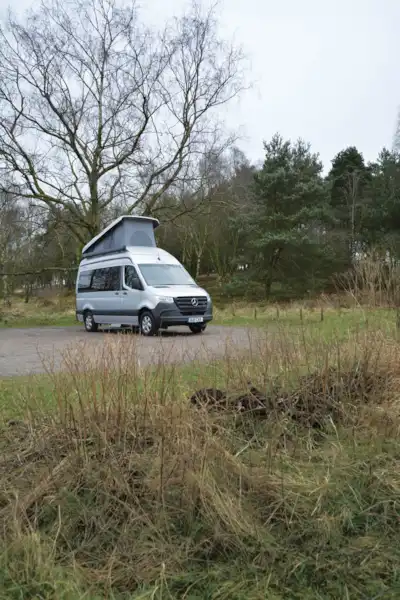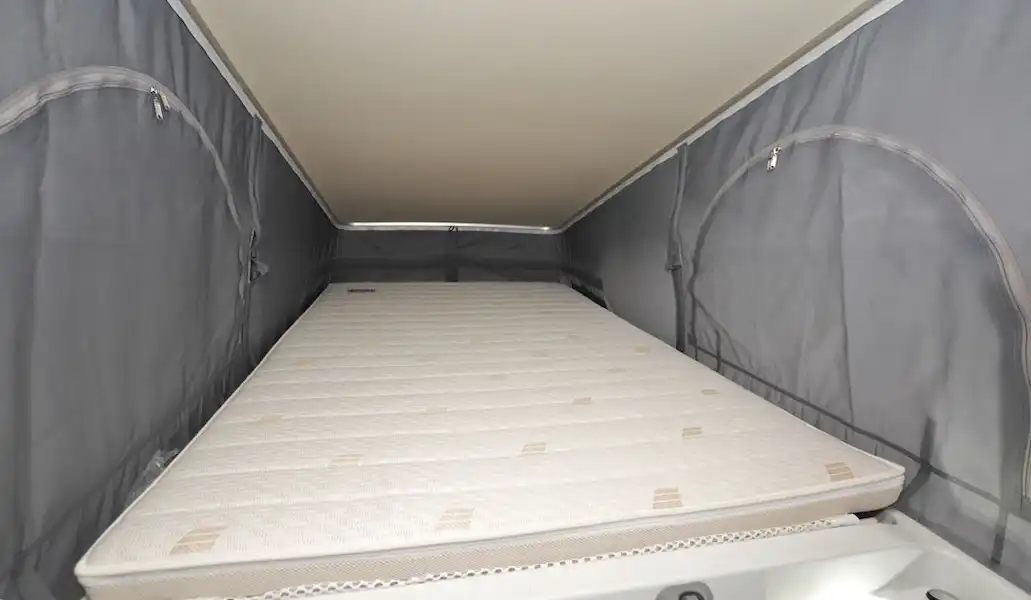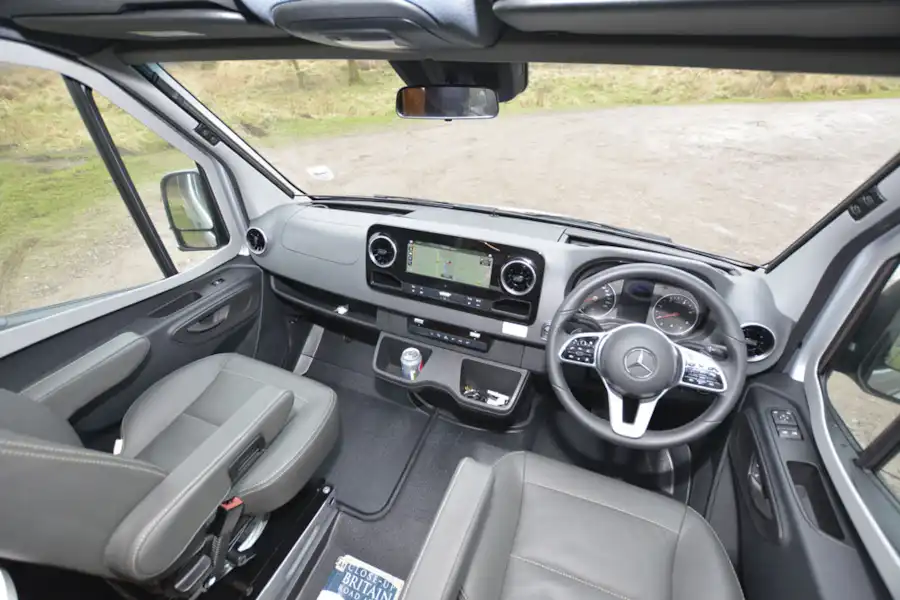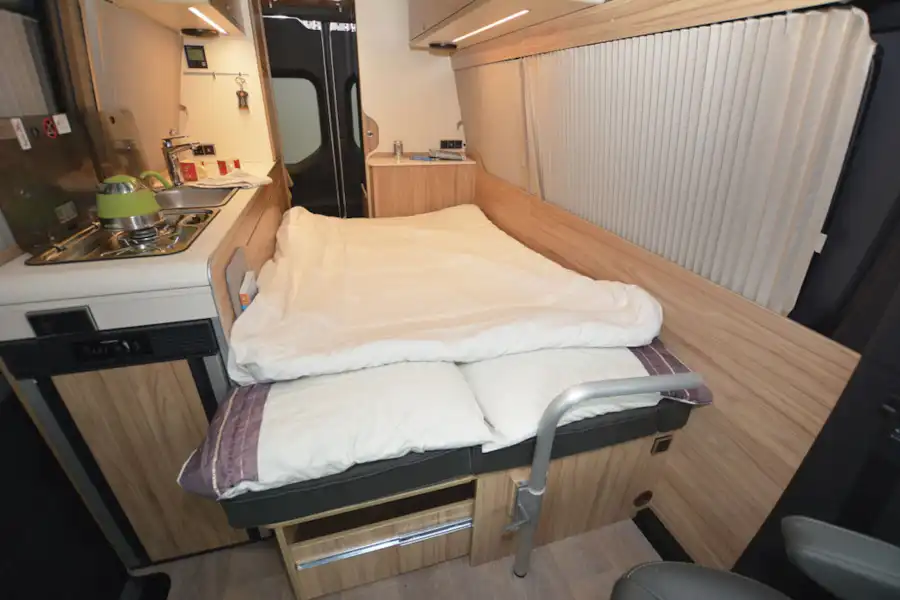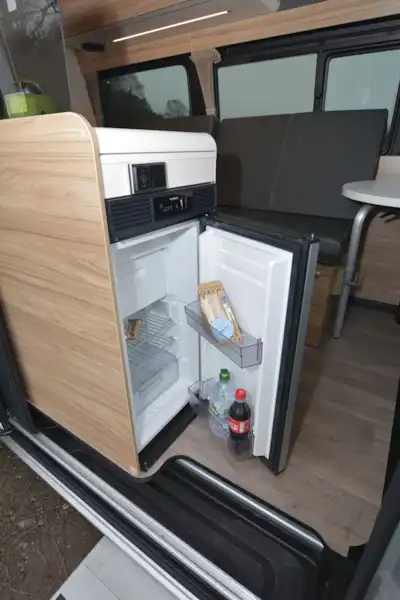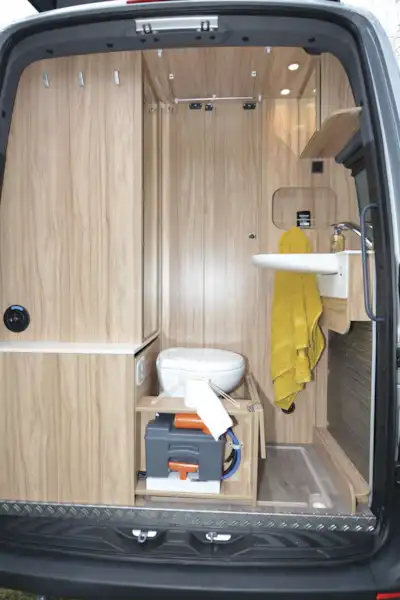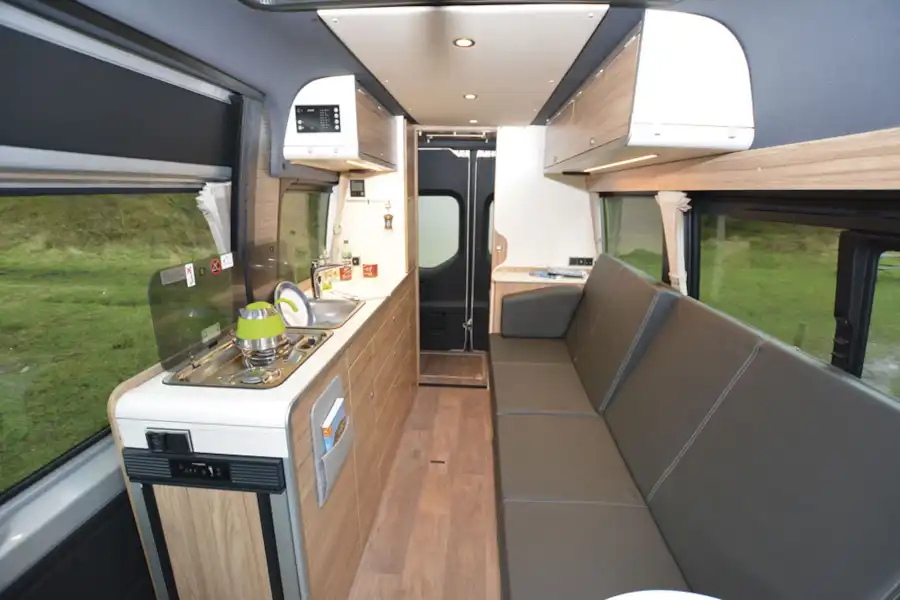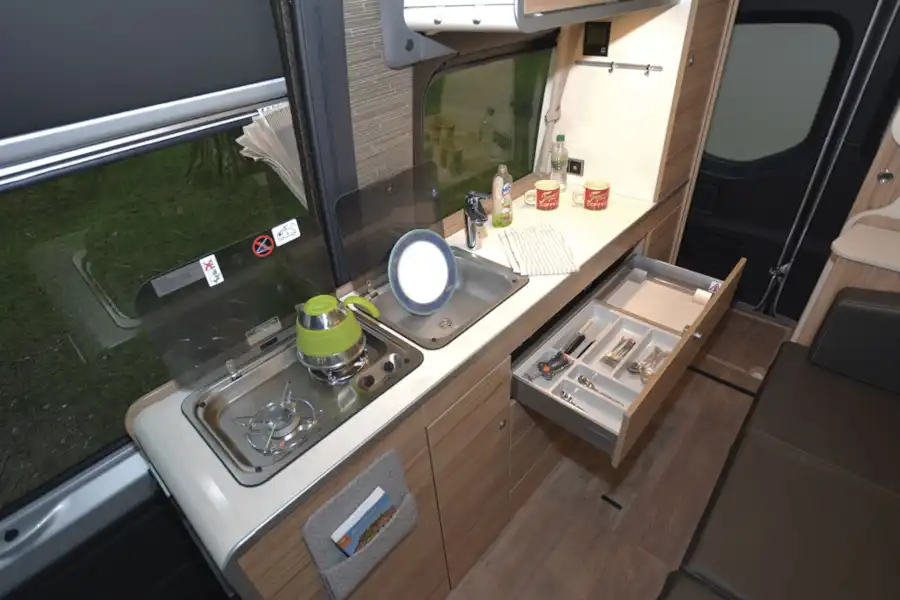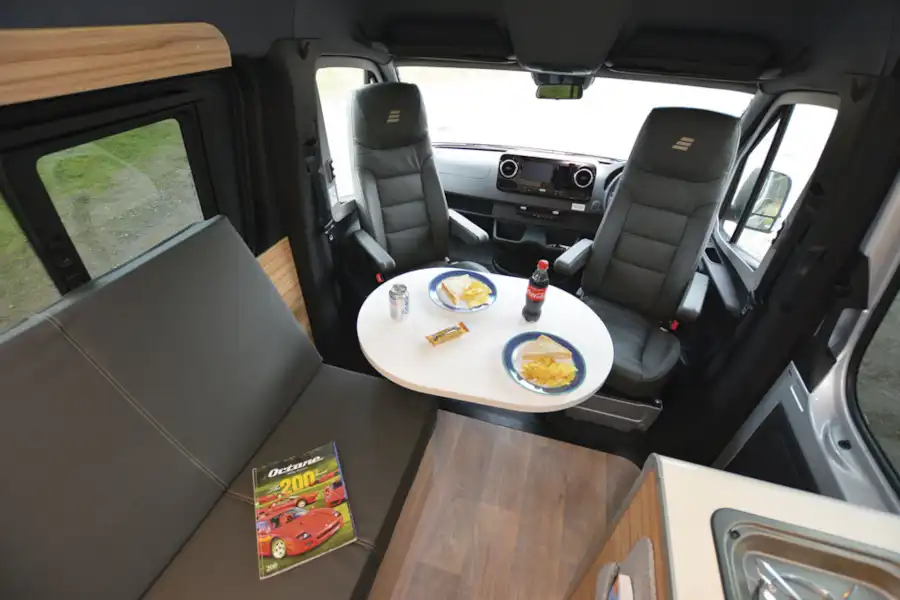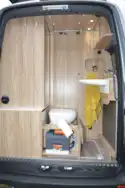Key Features
| Model Year | 2020 |
| Class | Rising Roof |
| Base Vehicle | Mercedes Sprinter |
| Price From (£) | 56210 excl VED |
| Length (m) | 5.93 |
| Berths | 2 |
| Belted Seats | 2 |
| Main Layout | End Washroom |
At a glance
Full review
Review by Peter Vaughan
It started life as a concept vehicle, the result of Hymer asking its German customers what they wanted in a van-based motorhome. Now, that concept has become a production vehicle designed wholly around the needs of just two people on tour.
Like the DuoMobil A-classes before it, this is Hymer doing things a bit differently and thinking specifically about couples. In fact, it bears almost no resemblance to Hymer’s other campervans, nor indeed other continental campervans.
Its base vehicle is a Sprinter, but one that’s fully glazed from Mercedes-Benz with deep tinted glass windows all around. With an absence of graphics and the standard black plastic front bumper (colour-coding is optional), there’s an almost austere appearance to it – or a more car-like look along the lines of a VW camper that’s grown up. If you plan on camping wild this is certainly a discreet vehicle in which to do so.
The Hymer DuoCar S is a compact motorhome
It’s surprisingly compact, too, at just 5.93m long and a smidgeon narrower than a Fiat Ducato. Somehow, it looks and feels smaller still, perhaps because it’s just so easy to drive. Or maybe because the ‘comfort suspension’ specified as standard for the DuoCar lives up to its name.
Visibility all-round is exceptionally good, too, and the optional 7G automatic gearbox makes for effortless driving. With the ‘gearstick’ being a stalk on the steering column, you don’t even have to take your hands off the wheel to engage park.
Nor do you need to turn a key to start the 2.1-litre diesel engine – there’s a button on the dash for that – but this Sprinter came with a conventional (but lay-flat) handbrake, rather than the electronic parking brake seen on some Mercs.
Fortunately, it doesn’t impede swivelling the cab seats. You sit in high-backed, multi-adjustable Aguti captain’s chairs (optionally in Grigio leather here), resulting in a rather Teutonic monotone cab interior, relieved only by the chrome rings around the turbine-style air vents.
The standard 143bhp engine seemed perfectly adequate for the job, with good cruising refinement (matched by a lack of conversion noise) but there are 163bhp and 190bhp (a V6) options if you plan on storming the autobahns or towing a trailer (upgraded to a 414 Sprinter, the DuoCar can tow up to 3,500kg).
This is a rear-wheel drive Mercedes, which many will find appealing – or for £8,780 extra you can have the four-wheel drive version.
For all its (many) impressive attributes, though, it’s the Mercedes’ tech that impresses most. The larger (10.25in) MBUX display might be a costly option (£2,260 including the reversing camera) but it’s a must-have feature. The touchscreen sat-nav and the clarity of the image when backing up make the systems offered in certain other base vehicles look like they’ve been borrowed from Noah’s ark.
You can also add more twenty-first century kit with the Driver Assistance Package – heat-insulating glass, High Beam Assist, Traffic Sign Assist, Active Lane Keeping Assist, Attention Assist and a heated windscreen. This motorhome also had the optional Distronic adaptive cruise control, while Crosswind Assist and Hill Start Assist are standard. Other options not fitted here include Blind Spot Assist, LED headlights and a 360-degree camera.
A simple layout in the Hymer DuoCar S
Of course, there are other Mercedes-based campervans, including two fixed bed models from Hymer itself, but none with a layout quite like this. It’s a simple design and not one you’d expect to see from a German brand.
The sliding side door remains on the continental side but it opens to reveal a long side-facing sofa opposite, with the kitchen stretching down the offside. The washroom completes the layout, across the tail end of the motorhome.
For a vehicle that’s usefully under 6m long, there’s a good feeling of space inside despite the Sprinter offering less internal room than an equivalent Fiat or Peugeot. What doesn’t impress, however, is the flat cushions of the settee, which look rather basic, even if their hide trim is well-finished.
MMM’s Deputy Editor came away from the DuoCar’s launch underwhelmed. I, on the other hand, saw potential in the example displayed at the NEC show and wanted to get to know the model better. And the longer I spent with the DuoCar the more I liked it…
It’s not just the spaciousness of the design, but the cab chairs are a great place for two people to sit and dine, using the oval table on its cranked leg.
Or maybe one of you would prefer to sit on the end of the sofa, facing the sliding door (hopefully wide open on a warm summer’s day with the flyscreen keeping bugs at bay).
The position of the table means that it doesn’t obstruct the centre aisle or comings and goings through the side door. However, I initially struggled with the fiddly adjustment of the table leg – I think you’d get the knack in time.
What I wouldn’t get used to is the gloomy headlining in the cab, compounded by a lack of spotlamps.
In contrast, the tinted habitation windows provided privacy without making the interior dark and, while there’s a dearth of reading lights in the DuoCar, the ceiling spots and dimmable LED strips under the top lockers do illuminate the space well.
If you’d rather sprawl on the settee than sit in an armchair, you can do that and, although the sofa might not look as sumptuous as one in an IH or an Auto-Sleeper, its raked backrest still makes it very comfortable.
It’s a pity that the only alternative upholstery is grey cloth, but you could easily brighten things up with colourful cushions.
Lots of storage in the Hymer DuoCar S
Along the offside, facing the settee, is a kitchen of almost unheard-of size for a ’van like this. It boasts a worktop 1.66m long and there’s a little slot-in extension at the forward end if that’s not enough! Joking aside, as it’s by the door it makes a useful serving shelf when eating al fresco.
You certainly won’t be short of meal preparation space in this campervan but you might be disappointed by the fact that cooking has to be done on a two-burner hob, as there’s no option to add a grill, oven or microwave.
What that does mean is that you get loads and loads of storage. At the forward end of the galley is a 70-litre compressor fridge with a door that opens from either side – perfect for getting a cold drink, whether you’re inside or out.
Next comes a tall shelved cupboard with the gas locker in its base. It only holds a small Campingaz cylinder but gas only goes to the hob as the blown-air heating and boiler are fed by diesel or mains electricity in this excellent but rarely seen version of the Truma Combi system.
Then there are three of the largest kitchen drawers you’ll ever see in a campervan, followed by a cupboard that conveniently houses the RCD and all the habitation area fuses.
Above the worktop, at the rear end of the galley, is a slide-out pantry unit that’s perfect for all your non-perishable grub and, finally, there’s a single top locker.
There’s a mains socket and two USBs adjacent to the kitchen worktop, plus the same opposite, alongside the useful top-loading cupboard here (an ideal place to rest your cappuccino while you loll about on the settee).
There are two more eye-level lockers (probably best used for clothes) on the nearside.
Then, under the sofa, the rear half houses the boiler and fresh water tank (inboard for proper winterisation) and the forward section is a massive drawer that will easily hold a double duvet and pillows.
Berths in the Hymer DuoCar S
The convenience of that bedding storage becomes even more obvious when you discover the, frankly, brilliantly simple bed make-up. The two drawers under the bed pull out and the seat bases unfold over the top.
The cushions and bed supports are in two halves, so nothing is awkward or ungainly to operate, and you sleep on the reverse of the cushions, which are soft fabric rather than leather. And not only is this bed ultra-easy to make, but it’s completely flat and very long.
With the bed made up, you can still get to the hob and the fridge, but not all the kitchen storage, so think about where to keep the teabags. There’s plenty of room to get undressed at the cab end and the front seats and table can still be used. And, in this DuoCar, there’s also a second bedroom.
As a £3,290 option, Travelworld had specified this example with the pop-top. It doesn’t create standing room (that’s already there to the tune of 1.89m) and is only here to offer an upstairs bed, which might seem odd in a motorhome with no rear seatbelts. However, it does give you options, in summer at least, of leaving the seats undisturbed and climbing the ladder to bed.
Once up top, you’ll find a bed that’s almost as big as the one below and just as comfortable (thanks to a one-piece mattress on plastic springs). You will have to turn yourself around, though, once you’ve got up the ladder as there’s limited headroom at the rear of the roof.
The biggest downside to sleeping up top, though, might be having to negotiate the ladder when you need the toilet in the night…
The washroom in the Hymer DuoCar S
The washroom is sited across the back of the camper, behind a sliding door, and comes with a surprisingly large wardrobe in the rear nearside corner (and outdoor chairs stored between here and the barn doors if you order that option). Two drain holes in the floor hint at a shower and there’s a head-height mirror on the offside, but this open and fairly roomy space hides its main facilities.
The washbasin is obvious as it simply folds upright. There’s plenty of room to use it but it’s one of those controversial backless numbers that requires a flow of water.
Where, then, is the toilet? Well, it slides out from under the wardrobe. You enter the washroom, turn around, and pull it out for use.
More of a compromise is the shower. Using the washbasin’s tap extended, there’s a fully enclosing shower curtain that clips to the ceiling. I wasn’t able to try this out, but you’ll surely find it clingy and claustrophobic and it seems unlikely that 100% of the water will find its way to the drain holes – and then you’ve got to find somewhere to store the soggy shower curtain.
In an emergency you’d, perhaps, give it a try but this is not a solution for folk who like to shower in their motorhome on a regular basis. At least water tank capacities are good – 100 litres fresh and 85 litres waste.
If you just want to wash off sand after a day on the beach, it might be more tempting to simply stand outside to hose yourself down (the DuoCar’s showerhead will reach).
With no rear step you will need to be agile to get into the motorhome via the back doors – the floor is at least 630mm above the Tarmac.
This motorhome review originally appeared in the April issue of MMM magazine - click here to buy a digital version of it.
Expert motorhome advice to your door!
Why not subscribe to one of our fabulous magazines and get expert advice, travel ideas, technical help and all the latest news for your motorhome and your motorhome adventures!
Want to know more about MMM magazine?
Every month MMM has articles written by motorhomers who have been there and done it, from great UK and European (and further afield) tours, campsite reviews, owners' reports and DIY projects among other things. MMM's tests, reviews and expert buying guides are not to be missed. MMM's technical advice is a must and includes everything from weekend jobs to longer-term DIY projects. And much more!
About MMM magazineWant to know more about What Motorhome magazine?
Every issue of What Motorhome magazine provides essential buying advice for anyone looking to buy a new motorhome or campervan or upgrade their existing model. With a pedigree of over 30 years of offering the best motorhome and campervan buying advice, every issue of What Motorhome includes more new motorhome and campervan reviews than you will find in any other magazine.
About What MotorhomeWant to know more about Campervan magazine?
Campervan is the exciting monthly magazine that will give you all the inspiration you need to explore the world in your campervan. Every issue is packed with real-life campervanning experiences, inspiring travel ideas in the UK and further afield, the best campsites to stay on, campervan road tests and reviews of the latest models, and much more!
About Campervan magazine

